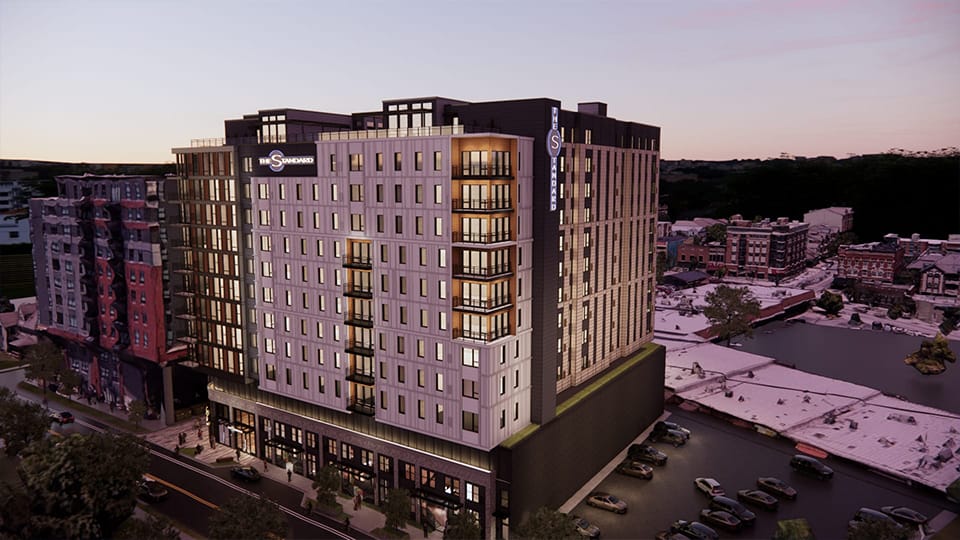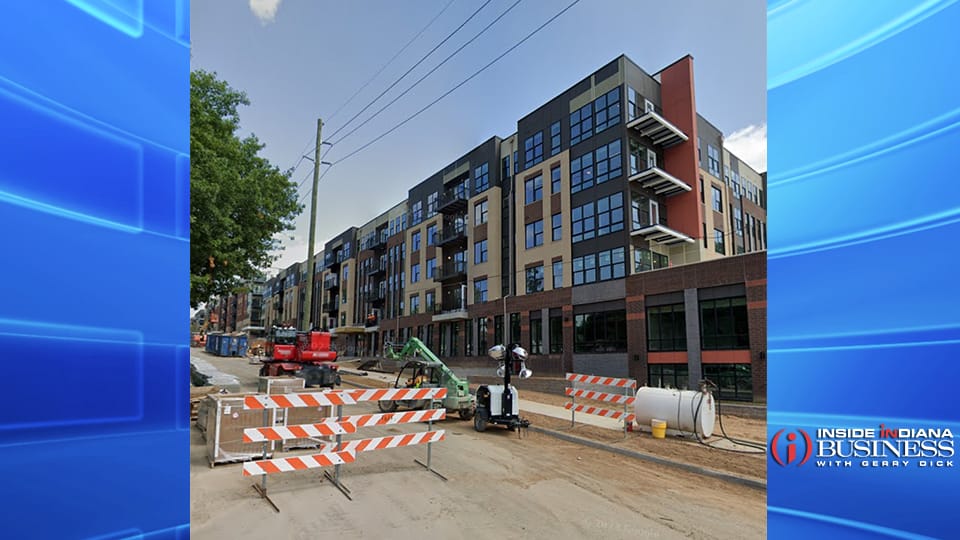Loading audio file, please wait.
Many parents dropping their kids off at college in the coming weeks will see a very different housing landscape than when they went to school.
The traditional image of off-campus student housing as spartan units run by local landlords is changing rapidly as each week brings news of national developers building huge, resort-style apartments in college towns.
In Indiana the trend is most visible in West Lafayette, where a string of major developments is reshaping the skyline near the campus of Purdue University.
In late July, Georgia-based Landmark Properties announced plans to build a 240,000-square-foot apartment complex with 680 beds just blocks away from campus on Pierce and Wood streets.
That project is dubbed The Standard—just like the 1,000-bed development Landmark opened in Bloomington for Indiana University students last fall. Landmark has built Standard properties near colleges in 22 states.
That announcement comes on the back of an entirely different company named Landmark Properties—based in Indianapolis—starting on a pair of seven-story apartment buildings a few blocks east at the corner of North River Road and State Street.
Adding to the list on Wednesday, The Verve celebrated its grand opening at 150 South Chauncey Street in West Lafayette. The Verve features another 750 beds, and its developer, Subtext, already has a Verve property in Bloomington.
All of these developments are geared towards students at nearby state colleges, though they are unaffiliated with the universities.
Supply and demand
To those watching the housing industry, the size and frequency of upscale developments targeting students aren’t surprising and come down to basic economics. Large state schools continue to see high enrollment, and a lack of university housing to keep up makes building big at Big 10 and SEC schools an attractive option.
“The student housing developers are focused on the large, state university. The small private schools that are generally struggling with enrollment are seeing very little of this type of student-specific development,” said George Tikijian, vice chairman at CBRE, an Indianapolis-based real estate services firm.
In 2021 Purdue reported an enrollment of 49,639. Two years later, that number increased to 52,211, partly due to 12 years of no tuition increases. But with its growing enrollment, Purdue has consistently struggled to build enough units on its own, leading to what some local officials have dubbed a “crisis.”
The clear demand has attracted developers to West Lafayette, Tikijian said, as has the types of students Purdue and IU admit.
“Places like IU and Purdue have a very high percentage of out-of-state and international students, both of which pay more tuition,” Tikijian explained. “And they’re generally more affluent so they can pay more rent.”
In Tikijian’s view, that’s what is leading many properties like Landmark to include amenities like rooftops lounges, pools, study spaces, workout rooms and even pickleball courts their developments.

Another amenity many new student-centric developments boast is proximity to campus. That’s something that’s changed in the past 15 years as fewer students own cars and developers rethink the cost-benefit analysis of paying more to build closer to campuses.
Even though properties closer to campus are more expensive, Tikijan said students are often willing to pay higher rents in exchange for being able to roll out of bed and get to class.
A spokeswoman for Landmark Properties said no one from the company was available to speak with Inside INdiana Business for this story. In an interview with the New York Times earlier this year, CEO Wesley Rogers said the amenities of Landmark’s units and their proximity to campus are possible due to the scale of the projects. “Having larger projects enables us to have more amenities as we can spread the costs out over a larger number of beds,” he told the Times.
Trickle-down housing?
West Lafayette officials also hope the new high rises have a trickle-down effect on housing for the city in general. Chad Spitznagle, West Lafayette’s building commissioner, said that Purdue students are currently living in a variety of units across the city and the hope is that they move into the student-specific units as they come online.
“Adding density to the downtown area is just going to remove students from our single-family neighborhoods and bring more opportunities for single families to live in single-family homes,” Spitznagle said.
But not everyone is happy with the trend of resort-style complexes next to campuses.
Some in Bloomington were dismayed as multi-floor buildings have gone up across the street from single-family homes in the past few years. Meanwhile, some students worry that the incoming high rises will push out cheaper units around campus.
Eva Reynolds voiced those concerns at a meeting of Tippecanoe County Area Plan Commission in June.
“I understand the importance of trying to find more beds and trying to fix the housing crisis. However, I don’t think adding more high rises and fixing the landscaping of West Lafayette is going to fix the housing crisis,” Reynolds said. “When you add apartment buildings that cost double the rent of what is currently at 222 Wood Street, it’s absolutely asinine to expect full-time students, who also work jobs, to be able to afford that.”
The Standard in Bloomington advertises a 325-square-foot studio apartment for $1,210 a month.
Story Continues Below

